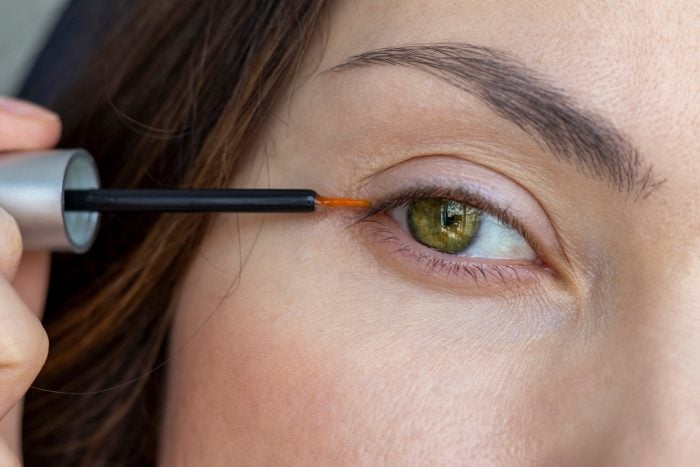Do You Use a Lash or Brow Serum? Beware of These Side Effects

Many hair growth serums contain prostaglandin, which is a drug, so you should actually be using these products under a doctor’s supervision.
If you’d like fluttery-long lashes or fuller brows, you’ve probably considered a lash or brow serum—but have you considered its side effects?
Hair growth serums are a big business—in 2020 the global lash serum market was valued at $752 million, and by 2032, it’s projected to reach $1.3 billion. But it seems like the potential side effects of hair growth products are just now becoming well known, thanks in large part to TikTok. Users are sharing their stories of experiencing not just allergic reactions such as redness and swelling (which can occur with any beauty product), but more alarming reactions such as discoloured or darker eyelids and loss of volume around the eyes.
Here’s the scoop: Redness, irritation, discolouration, volume loss and even iris colour change are all possible side effects of using a hair growth serum formulated with prostaglandin. But that doesn’t mean you need to avoid growth serums that contain the ingredient—you just need to know what to look out for.
We reached out to Jeff Donovan, a Whistler-based dermatologist specializing in hair loss, to learn how to safely use a hair growth serum and who may want to avoid it.
Best Health: What is prostaglandin?
Dr. Jeff Donovan: Prostaglandins are chemicals that the body makes to help regulate bodily functions. They’re also used in lash serums to help hair grow longer, darker and thicker—so these are chemicals that mimic what the body makes.
BH: How serious are the side effects of lash and brow serums with prostaglandin?
JD: We’ve known about the side effects for a long time—Latisse was approved in 2008 for treating lash growth problems, and we knew the side effects back then. What’s changed is that now, the FDA, Health Canada, the European Commission, and health regulatory agencies around the world have said these prostaglandin should not be in cosmetics because they’re drugs. And drugs need to be delivered with appropriate counselling, primarily because all drugs have side effects.
Prostaglandin products can cause allergic reactions, irritation, redness, itchy eyes, dry eyes, swelling of the eyes, red eyes and fat loss. When I prescribe Latisse to my patients, we do a lot of counseling about the potential side effects. But we don’t see them often. What we do see often is a lot of people pleased with the results.
BH: How long do side effects last?
JD: Prostaglandin can cause discolouration of the eyelid, meaning it looks like a person is wearing makeup. It can also cause fat loss, or hollowing of the eyes. If these effects are discovered early and patients are appropriately monitored, then they can reverse. But if someone’s been using the products for a long time, about a year or two, they don’t always reverse. Fortunately, that’s very rare. Redness, itchiness, irritation and excessive hair growth go away for most patients over time, but can take a while.
What to remember is these are drugs and all drugs need appropriate monitoring. Under appropriate monitoring, if a doctor is seeing redness, pigmentation, excessive hair, allergic reactions, fat loss, they can recommend the patient stops using the product. But if patients are using products without monitoring, then permanent problems can occur.
BH: What are the chances that one of these side effects will occur?
JD: Depends on the side effect. Fat loss is rare. A very low decimal percentage. Redness and irritation are not rare—one in every few dozen patients that use it, has those side effects.
BH: Should anyone definitely not try a lash or brow serum with prostaglandin?
JD: People who have eczema or irritated skin may be more likely to have these side effects. And people who already have issues with fat loss or fat distribution may not be great candidates for these medications.
Other than that, these side effects can happen to anyone. That’s why you should be monitored.
BH: What should you look for in a lash and brow serum?
JD: Look for products that have been studied so you know they’re safe. I would encourage people to discuss it with their healthcare providers, even if it’s a natural product.
This interview has been edited and condensed for clarity.
Next: Why Eyebrows Thin as You Age—and 3 New Ways to Spruce Them Up




